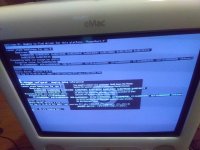In a previous life I used to be the sucker at my company stuck with putting together the "standard image" for the Mac laptops we issued to engineers. It's been 20 years, but here's my short summary of how OS X compatibility between models works:
- When Apple releases a new "retail" version it'll support whatever machines are in the wild at the time of its introduction. IE, if you had a retail 10.3 CD/DVD set it's going to be useless for any new model that came out after the day the disks were stamped even if the machine shipped with the "same" point release on it; some point versions of OS X were pretty long-lived, and if Apple introduced a new model in that time it'd have a "silently patched" version on it that didn't change the version number.
- Some early restore disks will happily install on any Mac, IE, you can take the disk that came with a new Mac and use it to install on your old Mac... with limits. (The "limits" being that while the OS installer itself would work "extra" software like any games or iMovie/iDVD/whatever would do a hardware version check when you ran the installer for them.) Later ones have a hardware check in the OS installer and refuse to install the OS unless hacked. (This latter situation kicked in sometime around the 10.3 era, I think, but I can't recall exactly when.)
- Regardless of whether there was an artificial block or not the OS itself shipping on a brand new Power Mac was usually just fine running on an old one if you use something like Carbon Copy Cloner (or the built-in disk imagine/blessing stuff) to copy a working install to an older Mac. IE, from what I can tell even the "machine specific" versions of OS X all involved "additive" changes; nothing was changed that prevents the OS from working on an older machine. (The one proviso there is that very late machines that only supported "classic" vs. being able to boot directly into OS 9 came with a brain-damaged version of OS 9.2 that will boot stand-alone on old machines but is missing pieces and is kind of broken.)
- The reverse also seemed to be *mostly* true, in the sense that if you had a version of OS X that predated a new machine but updated it to a point release newer than what was on the restore disks that came with that machine it would *probably* be okay if you imaged a fully updated OS install onto the newer Mac. I'm throwing the "mostly* in there because there may have been a couple exceptions I don't remember, especially involving G5s.
Based on these rules it was my SOP when a new PowerBook revision came out I would simply take one, install the additional software/preloads that we wanted in our standard image, and make an image of that new machine to be the new "golden image" used to redo *any* Powerbook that needed to be set up, whether it was more of the new model or leftovers/redo-s of older Powerbooks. It always worked fine; getting a working version of OS X onto your Mac shouldn't be rocket science.
Anyway, here's my probably flawed take on your eMac:
EveryMac says the 1ghz "PowerMac 4,4" eMac shipped with OS X 10.2.4. That is *well* before the retail release of 10.3, so I'd be pretty surprised you'd have problems running
any version of 10.3, whether it's a retail disk or a mismatched restore disk that doesn't have a locked installer. If you *were* trying to install off a locked installer you should be getting a message to that effect at the beginning, not randomly bombing out halfway through. That error message you got after the fact about not being able to find the platform driver is especially baffling: OS X installers will yell at you if they don't like your platform *before* installing.
What I think is going on is you have either bad RAM or a bad hard disk, and your installation attempts are getting corrupted. But that's just a guess.

